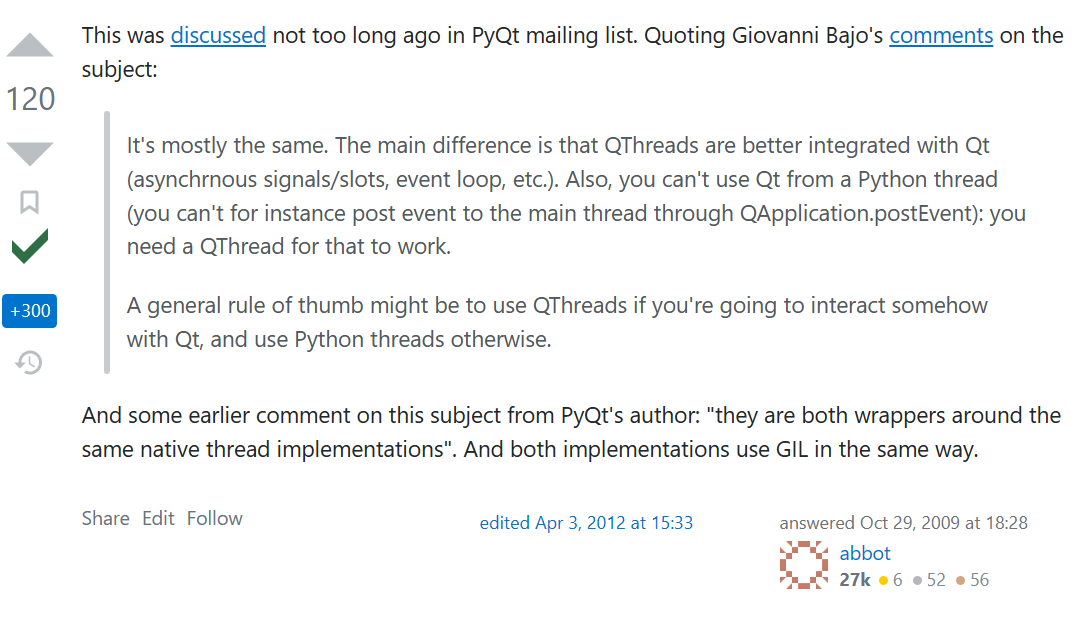前言
因为在网络上,特别是中文互联网上,关于Pyside6多线程的写法,特别是QThread的使用提及比较少,且较多使用不太推荐的写法,这篇博客主要是存下我自己参考的博客,希望对大家也有帮助。
一、QThread or Python libs[thread, process, ...]
在python中有多种实现多线程的方法,我一开始也纠结选哪种实现方式
在Stack Overflow的这篇回答中,可以大致窥得答案:QThread在Qt开发中一体性会更好,其他差别不大。
Stack Overflow文章的原文
补充资料
有位大佬写的【QT】 Qt多线程的“那些事”,虽然是Qt C++,但是也可以帮助了解Qt for Python。
二、QThread推荐实现方式 - moveToThread
在确定使用QThread后,发现QThread - Qt for Python 官方文档写得很一般,甚至给的example都不堪入目。
我在Stack Overflow的文章找到Pyqt5注释详细的实现,Pyside6的实现也就很类似,也很可以帮助理解QThread的建立过程,以及在Python多线程之threading.Thread()基本使用和QT信号和槽在哪个线程执行问题的博客中,可以进一步浅尝实现的区别。
Stack Overflow文章的原文以及给出的代码实现
Take this answer updated for PyQt5, python 3.4
Use this as a pattern to start a worker that does not take data and return data as they are available to the form.
1 - Worker class is made smaller and put in its own file worker.py for easy memorization and independent software reuse.
2 - The main.py file is the file that defines the GUI Form class
3 - The thread object is not subclassed.
4 - Both thread object and the worker object belong to the Form object
5 - Steps of the procedure are within the comments.# worker.py
from PyQt5.QtCore import QThread, QObject, pyqtSignal, pyqtSlot
import time
class Worker(QObject):
finished = pyqtSignal()
intReady = pyqtSignal(int)
@pyqtSlot()
def procCounter(self): # A slot takes no params
for i in range(1, 100):
time.sleep(1)
self.intReady.emit(i)
self.finished.emit()
# main.py
from PyQt5.QtCore import QThread
from PyQt5.QtWidgets import QApplication, QLabel, QWidget, QGridLayout
import sys
import worker
class Form(QWidget):
def __init__(self):
super().__init__()
self.label = QLabel("0")
# 1 - create Worker and Thread inside the Form
self.obj = worker.Worker() # no parent!
self.thread = QThread() # no parent!
# 2 - Connect Worker`s Signals to Form method slots to post data.
self.obj.intReady.connect(self.onIntReady)
# 3 - Move the Worker object to the Thread object
self.obj.moveToThread(self.thread)
# 4 - Connect Worker Signals to the Thread slots
self.obj.finished.connect(self.thread.quit)
# 5 - Connect Thread started signal to Worker operational slot method
self.thread.started.connect(self.obj.procCounter)
# * - Thread finished signal will close the app if you want!
#self.thread.finished.connect(app.exit)
# 6 - Start the thread
self.thread.start()
# 7 - Start the form
self.initUI()
def initUI(self):
grid = QGridLayout()
self.setLayout(grid)
grid.addWidget(self.label,0,0)
self.move(300, 150)
self.setWindowTitle('thread test')
self.show()
def onIntReady(self, i):
self.label.setText("{}".format(i))
#print(i)
app = QApplication(sys.argv)
form = Form()
sys.exit(app.exec_())下面是我自己再写的实现
class Worker(QObject):
ready = Signal()
# 貌似finished信号,Qt自己有定义(?)
finished = Signal()
def __init__(self):
super().__init__()
def DoWork(self):
# 或者设置一个变量作为是否停止的标准,然后用某一个槽函数修改它即可
while True:
# print('hello, QThread')
self.ready.emit()
self.finished.emit()
class ...:
def __init__(self):
super(..., self).__init__()
self.worker = Worker()
self.workerThread = QThread()
self.worker.moveToThread(self.workerThread)
self.workerThread.started.connect(self.worker.DoWork)
self.worker.finished.connect(self.workerThread.quit)
self.worker.ready.connect(self.xxx)
self.workerThread.start()
def xxx(self):
pass其他小问题
中途有遇到将信号(Signal)在实例(self)上定义是不行的错误。
在关于python:’PySide.QtCore.Signal’对象没有属性’connect’末尾有提到,需要将信号(Signal)定义在类(class)上。
UPD - 2023.2.15
根据一些文章的对最终槽函数在哪个线程运行的分析,应该还是把要运行的槽函数定义在Worker类里的样子,关于UI的修改是要在主线程中进行。


Comments | NOTHING
该文章已经关闭评论